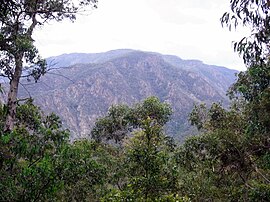Wadbilliga National Park
| Wadbilliga National Park New South Wales | |
|---|---|
IUCN category Ib (wilderness area) | |
 | |
| Nearest town or city | Cobargo |
| Coordinates | 36°28′S 149°35′E / 36.467°S 149.583°ECoordinates: 36°28′S 149°35′E / 36.467°S 149.583°E |
| Established | 30 March 1979 |
| Area | 985.3 km2 (380.4 sq mi) |
| Managing authorities | NSW National Parks & Wildlife Service |
| Website | Wadbilliga National Park |
| See also | Protected areas of New South Wales |
Wadbilliga National Park is a 985.3 km2 (380 sq mi) national park that is located in high country spanning the Monaro and South Coast regions of south-eastern New South Wales, Australia.
Contents
Location and features[edit]
Wadbilliga National Park is located 425 kilometres (264 mi) southwest of Sydney via Cobargo, and 150 kilometres (93 mi) south east of Canberra. The nearest towns are Narooma and Cobargo in the east, and Cooma on the plateau in the west.
Wadbilliga is a wilderness area, and much of its protected area is in a near pristine state.[1] Featuring rugged gorges and gullies. Suited to overnight camping and wilderness walking (only for the most experienced and well prepared). Areas of interest include the Tuross Falls, the Tuross River Gorge and Brogo Wilderness Area. The Wadbilliga Track is a scenic four wheel drive road which travels up the escarpment from east to west.
Wadbilliga is in a remote part of Australia, and has had little influence from mankind in the history of European settlement. In recent decades, it has become protected, and has intentionally been left in a natural state.[citation needed]
Flora[edit]
The undulating plateaux and steep gullies provide a variety of different habitats. Pinkwood rainforests occur in the sheltered fire free gullies. Black Ash, Monkey Gum, Messmate, White Ash and Snow Gums occur at higher altitudes. Yellow Box, Manna Gum and Forest Red Gum forests are found at lower altitudes. Other habitats include bogs, dry exposed eucalyptus woodland, riverside forest, swamps and heaths. Rare plants occurring in Wadbilliga National Park include the Deua Gum and the small shrub, Kunzea badjaensis.[citation needed]
Fauna[edit]
The bird and animal life is relatively undisturbed in this area. Over 122 native species of birds have been recorded here. Common animals include wombats, kangaroos, wallabies, possums of various types, platypus, echidna and many more.[citation needed]
Gallery[edit]
See also[edit]
References[edit]
- ^ National Parks & Wildlife Service - information pamphlet December 1998
External links[edit]
| This New South Wales protected areas related article is a stub. You can help Wikipedia by expanding it. |






No comments:
Post a Comment